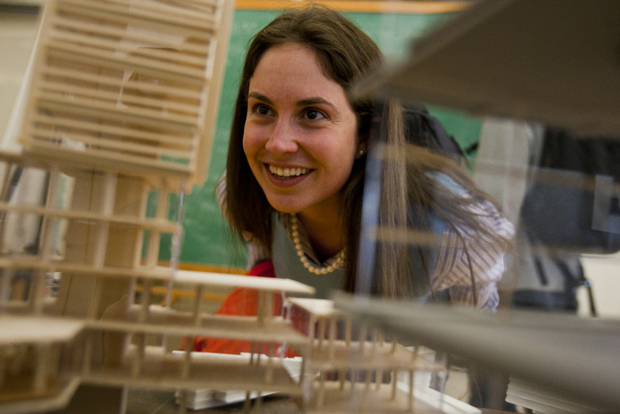‘Pop-up’ lab opens interdisciplinary dialogue

For architecture professionals, sometimes work can feel more like running a political campaign than designing the next generation of buildings and public spaces.
That’s what Tim Love, an associate professor of architecture in the College of Arts, Media and Design and a principal at the downtown firm Utile, said at Monday’s open studio event in Northeastern’s architecture studio, an always-busy hub of student work located in the Ruggles T station. With architecture chair George Thrush, Love was showing off plans to redesign Boston’s City Hall Plaza, a vast concrete expanse in what was once Scollay Square.
“Any public project requires a dialogue from the very beginning of the process,” Love said. “Even here, when I’m talking about this work in more of an academic setting, I’m also working to build support for this project. Everyone here is, in some way, a constituent of City Hall Plaza.”
Students and faculty alike presented their work at “Urban Utopias? An Open Studio,” Northeastern’s second Pop-Up Open Lab Experience, which was sponsored by the Office of the Provost and the School of Architecture. The series is designed to foster collaboration and dialogue between disciplines. (The first event was held last December in the Interdisciplinary Affective Science Laboratory where psychology professors Lisa Feldman Barrett and Karen Quigley study human emotion.)
Kelsey Holmes, who is in her final semester of the five-year architecture program, said opening up the studio — usually packed with only students and professors from her major — gave her an opportunity to talk about her work with members of the Northeastern community who are not as intimately familiar with architecture as her peers.
“It’s been really great to get feedback from other students, who certainly experience architecture every day but bring whole new perspectives,” said Holmes, who was showing off models of a recent mixed-use building she designed for a studio class. “We don’t really get to do this much — talk about our work to people outside our program — so it’s been a really beneficial experience.”
Thrush said the architecture program was an excellent choice to highlight with an open lab because the work students and faculty do is accessible to people without advanced training in the field.“Even though the average person doesn’t do this work,” Thrush said, “they recognize and understand what we’re doing, and can even bring their own ideas into the dialogue.”
Next month, Thrush and several architecture students will be featured in a video essay on future challenges facing designers that will be shown at the National Convention of the American Institute of Architects in Washington, D.C.




